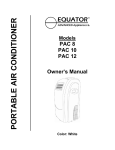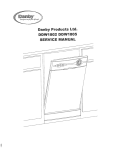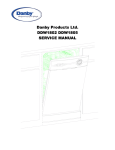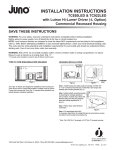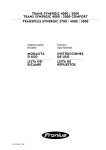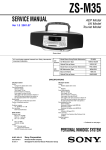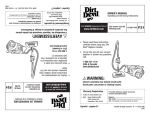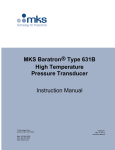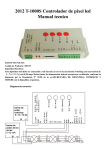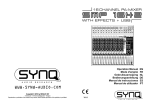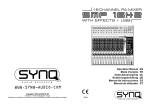Download Equator SB 818 User's Manual
Transcript
EQUATOR SERVICE MANUAL AND SPARE PARTS CATALOG First Edition - March 2005 18" DISHWASHERS MODEL: WB 818 SB 818 www.EquatorOnline.com Advanced Appliances CONTENTS SPECIFICATIONS……………………………………3 SCHEMATIC DIAGRAM……………………………… 4 WIREING DIAGRAM……………………………………5 TIMER CYCLE CHART………………………………… 6 COMPONENT OPERATION AND REPAIR……………… 7 Safety Precautions…………………………………………… 7 Timer……………………………………………………………………7 Door Latch and Switch Assembly…………………………………… 8 Float Switch Assembly…………………………………………… 8 PRODUCT EXPLODED VIEWS…………………………………10 TROUBLESHOOTING…………………………………………… 2 14 SPECIFICATION MODEL Rating Motor (HP) Motor (Amps) Heater Wattage Wash Total Amps (Load Rated) Thermostat Contacts Close at ELECTRICAL 120V 60Hz 1/5 1000W 9.2A 127°F ±5°F 58℃±3℃ WATER SUPPLY Suggested Min. Incoming Water 120°F to 150°F 49℃ to 66℃ Temperature Pressure (PSI) Minimum/Maximum 15/120 PSI Connection (NPT) 3/8” 3.5±5% Consumption (Toil Gallons) 1.08GPM±10% Water Valve Flow Rate (GPM) 3 Schenmatic Diamgram of Dishwasher (WQP8-9223 and WQP8-9324) code component L G N IG code thermic-hypersensitive switch SMP20 1 C1 T1 D12 D15 D13 C2 ACN 11 D-LED D1 D2 D3 D4 D5 D6 D7 D8 10 TR2 S PS K1 K2 K3 K4 TR3 19 9 TR4 EV1 IS 8 TR6 P1 SMP16 D/Ed 17 TR7 contoller 18 TR5 EV2 2 1 1 9 3 TR8 7 3 1 3 11 2 5 6 TR10 BUZ IAQS TR9 16 13 RE VCC 7 RY1 D9 15 RY2 5 D10 16 ISS 15 8 ISB R1 D11 ACN ACL 13 4 D14 20 TR1 MIC1 S ML ITR(78) C3 C4 component 7805 D/Ed dispenser EV2 softener valve C power switch IG quicksilver switch ISB thermic-hypersensitive switch ITR rinse aid warning light D9 washing pump ML water level switch P thermic-hypersensitive resistance RE VCC Cn EV1 IAQS IS ISS LS D10 PS R1 S capacitor inlet valve flowt switch door switch salt switch power switch salt warning light drain pump heating element AC110/120V 50/60Hz Wiring Diagram of Dishwasher (WQP8-9223 and WQP8-9324) component L G N C1 D12 D15 D13 ACN 11 D-LED TR5 18 TR10 K1 K2 K3 K4 TR4 6 white 9 TR6 TR1 20 SMP16 TR3 17 1 3 S 9 2 P1 1 20 TR2 red contoller IS S ML PS 3 1 2 11 3 IAQS TR9 16 white 5 BUZ 13 pink TR8 RE VCC black 7 RY2 ISB 5 gray D9 16 15 D10 RY1 15 8 black IG 1 T1 D14 D1 D2 D3 D4 D5 D6 D7 D8 TR7 17 C R1 D11 ACN ACL 13 5 C2 C3 SMP20 EV1 green white ISS gray ITR(78) pink red green C4 component EV2 white SMP20 code 7805 D/Ed dispenser D/Ed EV2 softener valve power switch IG quicksilver switch ISB thermic-hypersensitive switch ITR rinse aid warning light D9 washing pump ML water level switch P0 thermic-hypersensitive resistance RE yellow VCC capacitor inlet valve flowt switch door switch salt switch power switch salt warning light drain pump heating element thermic-hypersensitive switch white green code Cn EV1 IAQS IS ISS LS D10 PS R1 S red gray gray AC110/130V 50/60Hz gray TIMER CYCLE CHART COMPONENT OPERATION AND REPAIR SAFETY PRECATIONS Always turn off the electric power supply before servicing any electrical component, making ohmmeter checks, or replacing any parts. All voltage checks should be made with a voltmeter having a full scale range of 130 volts or higher. After service is completed, be sure all safety-grounding circuits are complete, all electrical connections are secure, and all access panels are in place. CIRCUIT BOARD With the circuit board, user selects the various cleaning cycles of the dishwasher with press the button. The circuit board controls all the electrical functions of the dishwasher in all stages of each cycle. All functions can be traced on the chart. Diagram provided in this service manual. To Test Circuit Board If the circuit board is suspected of faulty operation, reference chart and electrical schematic diagram and proceed as follows: 1. Index the circuit board to all of the increment of the cycle, each of the indicators light should is bright. 2. Index the circuit board to one of the increment of the cycle, which is a drain period. 3. If the pump motor fails to operate during the first cycle increment, check for power at the pump motor connector block, if there is no power check the door latch switch, if there is power, check the pump motor as described in this section. 4. If a component controlled by the circuit board fails to function as the circuit board advances through the cycle, check for voltage at the circuit board terminals. If the check voltage is supplied to the component, check the component as described in this section. Continuity through circuit board contacts, other controls, and wires can also be checked with an ohmmeter with electrical power disconnected. If the circuit boards contacts fail to close in the sequence shown on the chart are burned (have resistance measurable with an ohmmeter), or if circuit board does not run automatically, replace the circuit board. To Replace Circuit Board 1. Disconnect dishwasher from electrical supply. 2. Remove the power button. 6 POWER BUTTON Figure 1 Figure 2 3. Remove the screws which locking the control panel (See figure1). Remove the power button and unscrew the screws which locking the circuit board behind the control panel. (See Figure 2 and 3.) 4. Take down the damaged circuit board and install a new circuit board, reverse procedures to complete repairs. (See figure 3and 4.) Figure 3 Figure 4 DOOR LATCH AND SWITCH ASSEMBLY The latch and switch are located in the door assembly behind the control panel. The dishwasher will not operate until the door is closed; the latch engages the door catch. To Test Or Replace Door Switch. 1. Disconnect dishwasher from electrical supply. 2. Remove screws securing the control panel to the inner door (See Figure 1). 3. Remove wire leads from latch switch. 4. Use ohmmeter and check switch for continuity. 5. If the switch tests is good. Check dishwasher electrical power. Check to see if timer is defective. If switch is defective remove door switch from latch assembly. 6. Install new switch and reverse procedures to complete repairs. 7 To Replace Door Latch Assembly 1. Disconnect dishwasher from electrical supply. 2. Remove screws securing the control panel to the inner door. 3. Remove wire leads from door latch and remove screws securing door latch assembly to inner door. (See Figure 5.) SCREW FLOAT SWITCH WIRE LEAD SWITCH DOOR WIRE LEAD LATCH Figure 5 Figure 6 4. Install new door latch assembly and reverse procedures to complete repairs. FLOAT SWITCH ASSEMBLY The water float assembly is located in the right lower side of the dishwasher (the portable located behind the lower front crosspiece). When too much water enter the dishwasher,the water will enter the float support through the overflow pipe, the float will make the floating switch acts, the electrical supply to the water valve will disconnected and the drain pump keep on working. If the switch fails to operate, check the following: ● Loose connection at the switch terminal. ● Switch not installed properly. ● Warped stem on float, not contacting the actuator blade. ● Float support restricts free float movement. ● Check if the float support is cracked. ● Food or foreign material restricting free float movement. ● If the rubber cap lost(See figure7). RUBBER CAP THERMOSTAT SENSOR 8 Figure 7 Figure 8 To Remove Or Replace Float Switch 1. Disconnect dishwasher from electrical supply. 2. Remove electrical leads to float switch. 3. Take down the switch from float support. 4. Install new float switch and reverse procedures to complete repairs (See figure 6). 9 TROUBLESHOOTING The troubleshooting cheek list is common for all dishwasher models. They use different parts to accomplish the same thing and diagnosis will remain similar. When a problem arises, and a possible cause is listed, follow the test, remove or replace procedures as outline in this service manual. The wiring diagram, shematic and timer cycle chat is a necessity when making electrical checks. In most cases an ohmmeter will handle all the tests necessary. For checking any particular cycle of operation, it absolutely necessary that the cycle be set up as outlined in the product owner’s guide. CHECK THE FOLLOWING SYMPTOM Dishwasher will not operation when turn on REMENDY ●fuse (blow nor tripped) ◇Replace fuse or reset breaker. ● Supply line receptacle, wiring ◇Repair or replace. harness. ● Circuit board (contacts open or ◇Replace circuit board. burnt). ◇Replace motor. ● Motor (inoperative, check resistances). ◇Replace door switch. ●Door switch (open contacts) ◇ Replace or adjust to make ●Door latch not making contact with contact. door switch. Dishwasher stop washing ● Overflow occur. ◇ Check the reason of overflow but draining pull out the rubber cap wait for a minute let water pour out. Water can’t pour out from ●Hole in the float supply is jammed. float support when pull out ◇Suck with dust cleaner or other let water pour out. the rubber cap. Dishwasher runs but not ●heater element (open). ◇Replace heater element. heat ●Timer contacts (open or burnt). ◇Replace timer. ● Wiring or terminal (burnt or ◇Repair or replace. broken). Dishwasher will not stop. ● Thermostat is closed. ◇Replace. ●Timer motor (inoperative). ◇Replace timer. ● Wiring or terminal (burnt or ◇Repair or replace. broken). Dishwasher runs with door ●Timer (open or burnt contact). ◇Replace timer. ●Defective door safety switch. ◇Replace door safety switch. ●Start winding(open). ◇Replace motor. open Motor hums but will not 10 ● Motor (bad bearings or locked start or run. ◇Replace motor. rotor). ●Start relay not dropping out. ◇Replace start relay. terminal thermal overload ●Improper voltage. ◇Check voltage. protector. ●Seal faces binding. ◇Repair or replace. ●Motor shaft binding. ◇Repair or replace. ●Motor windings shorted. ◇Repair motor. ●Glass or foreign items in pump. ◇Clean and clear area. ● Circuit board (contacts open or ◇Replace circuit board. burnt) ◇Replace timer. Motor trips out on in Repeated dishwasher cycles ● Motor (inoperative, check resistances). ● Damaged circuit board. ◇Replace circuit board. ●Check circuit for power ,check if ◇ Reconnected wire and circuit the wire misconnected. board . ●Have wire cut off ◇Repair. Dishwasher will not fill with ●Water supply turns off. ◇Turn water supply on. water. ●Defective inlet valve. ◇Replace inlet valve. Dishwasher does not advance automatically. ● Check valve screen for ◇Disassemble and clean screen. obstructions. Incomplete water fill. ●Defective float switch. ◇Replace switch. ●Damaged circuit board. ◇Replace circuit board . ●Wiring (broken or burnt). ◇Repair or replace. ●Low water pressure. ◇ Minimum water pressure of 15P.S.I ●Clogged water inlet valve screen. ◇Clean water inlet valve screen. ● Heavy ◇ Use dishwasher when water water supply usage elsewhere in home. usage is at a minimum. ●Kinked or restricted fill hose, water ◇Correct as needed. inlet valve to fill tunnel. Too much water fill. ●Water inlet fill valve defective. ◇Replace water inlet fill valve. ● Damaged circuit board ◇Replace circuit board. (open or burnt). ● Float arm binding or out of ◇Repair, adjust or replace. adjustment. Dishwasher will not pump ●Drain pump is restricted. ◇Clear restrictions. out. ●Damaged impeller. ◇Replace drain pump. ●Wiring or terminal (contacts open ◇Replace circuit board. or burnt). Water siphons out. Water leaks. ●Drain hose loop to low. ◇Move to proper height. ● Drain line connected to a floor ◇Install vent air gap at counter drain not vented. top. ●Spray arm not rotating or split. ◇ Check for proper rotation or replace spray arm. 11 ● ◇ Check and correct for proper Overcharge of water. fill. ●Tub seal (torn, worn or loose). ◇Replace tub seal. ● Dishwasher ◇ Adjust door latch assembly door not sealing properly. and/or strike. ●Dishwasher is not level. ◇Level dishwasher properly. ● Overburden (wrong type of ◇Instructs customer/user. detergent). ●Hose clamps loose. ◇Tighten all clamps securely. ● Heater element mounting nuts ◇Tighten the nut. loose. ●Water seal leaking. ◇Use a new water seal. ●O-ring is not in position. ◇Adjust the ring or replace a new. ● Motor and pump assembly not ◇Replace seal. seated proper in tub liner bottom. Poor wash ability. ●Spray arm not rotating. ◇Check for proper rotation. ●Improper loading of dishes, pans ◇ Instructs and other. proper loading customer/user per on owner’s guide. ●Detergent dispenser inoperative. ◇Repair or replace dispenser. ● Insufficient amount of detergent. ◇On proper amount of fresh deter Or the detergent is old. gent to use. ●Damaged or the impeller is broken. ◇Replace pump assembly. ●Detergent ◇Incoming water temperature not dissolve. 140 ° F of is required to proper dissolve detergent. Poor drying of dishes ● Improper loading of dishes, pots ◇ Instruct and other. proper loading per owner’ s guide. ●Heating element (open). ◇Replace heating element. ● Incoming water temperature too ◇Incoming water temperature of low. 140°F for best drying results. ● Wiring or terminal (broken or ◇Replace or repair. customer/user on burnt). ●Cup binding. ◇Repair or replace. ●Roll pin retainer or shaft broken. ◇Replace pin, retainer or shaft. ●Defective bi-metal. ◇Repair or replace. ●Timer contact (open or broken). ◇Replace timer. Door will not lath. ●Door latch damaged. ◇Replace door latch. Rinse agent liquid will not ●Electromagnetic valve defective. ◇Replace valve. eject. ●Rinse agent dispenser not mounted ◇Mount securely to rear of inner correctly. door panel. ● Plunger stuck or held in closed ◇Free plunger or adjust plunger position. release. ●Container cracker or broken. ◇Replace container. Detergent cup will not open. Rinse agent liquid leaks. 12 ●Defective seal on plunger. ◇Replace plunger. ●Over filling container. ◇ Follow instructions in owner’s manual. Noisy pump assembly. ●Impellers not properly shimmed or ◇ Use shim gauge furnished in rubbing. impeller and seal kit, when seals are properly impellers will shimmed be in the correct operating position. ●Pump parts not properly installed. ◇Inspect and correct. ●Debris in bottom of tub sump area. ◇Clean out sump area. ●Defective motor bearings. ◇Replace motor. Dishwasher continues to fill ● Something or continues to fill even material) under diaphragm in water though in case of there is no inlet valve. voltage to fill valve. ●Defective water inlet fill valve. ◇Replace water inlet valve. Detergent left in dispenser. ●Detergent cup held or blocked by ◇On proper loading dishes. (dirt or foreign ◇ Clean water inlet valve or replace. large dishes. ● Dispenser wet when detergent ◇Instructs customer/user. was added. ●Softener broken. ◇Replace softener. ●Softener nut loosen. ◇Screw down softener cap. ●Air inlet nut loose. ◇Screw down air inlet nut. ●Air inlet install up side down. ◇Reinstall air inlet properly. ●Inlet Valve Damaged. ◇Replace Inlet Valve. ●Inlet Valve Disconnected. ◇Reconnected Line. Window Display “E2” ●Pressure Switch Damaged. ◇Replace Pressure Switch. Window Display “E3” ●Heating Element (open). ◇Replace. ●Power Supply To heating Element ◇Reconnect Softener leaking Leaking form air inlet. Window Display “E1” Line. Cutting. Window Display “E4” ●Float Switch Act. ◇Take Remove The Rubber Cap Let Water Pour Out. Window Display “E5” ●Thermostat Sensor Damaged. 13 ◇Replace sensor(See figure8).













